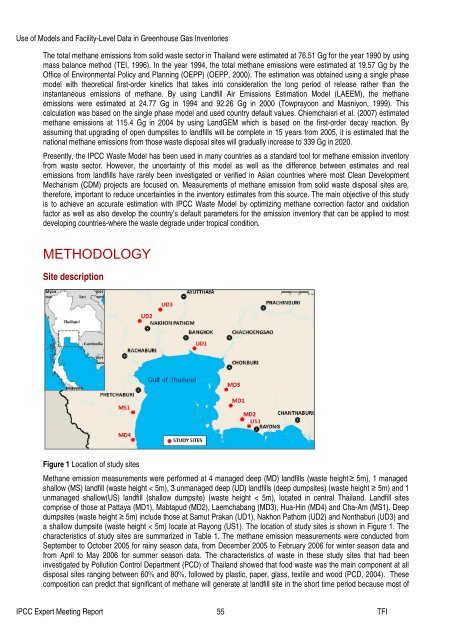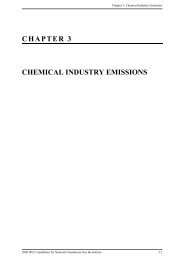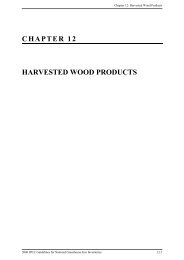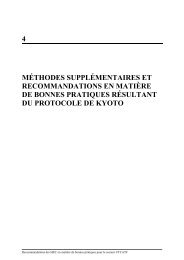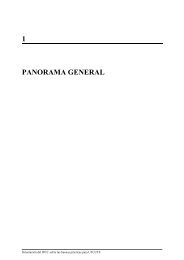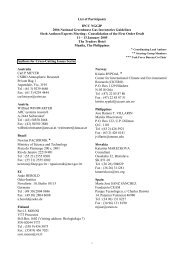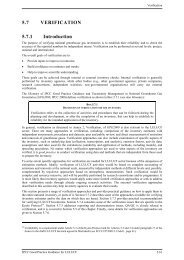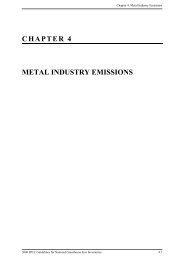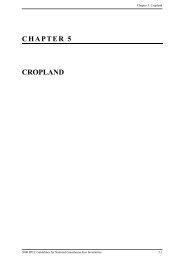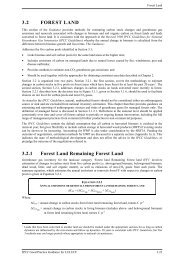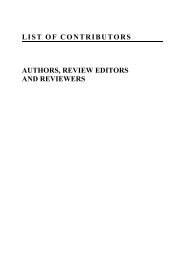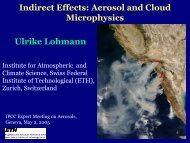Use of Models and Facility-Level Data in Greenhouse Gas Inventories
Use of Models and Facility-Level Data in Greenhouse Gas Inventories
Use of Models and Facility-Level Data in Greenhouse Gas Inventories
Create successful ePaper yourself
Turn your PDF publications into a flip-book with our unique Google optimized e-Paper software.
<strong>Use</strong> <strong>of</strong> <strong>Models</strong> <strong>and</strong> <strong>Facility</strong>-<strong>Level</strong> <strong>Data</strong> <strong>in</strong> <strong>Greenhouse</strong> <strong>Gas</strong> <strong>Inventories</strong><br />
The total methane emissions from solid waste sector <strong>in</strong> Thail<strong>and</strong> were estimated at 76.51 Gg for the year 1990 by us<strong>in</strong>g<br />
mass balance method (TEI, 1996). In the year 1994, the total methane emissions were estimated at 19.57 Gg by the<br />
Office <strong>of</strong> Environmental Policy <strong>and</strong> Plann<strong>in</strong>g (OEPP) (OEPP, 2000). The estimation was obta<strong>in</strong>ed us<strong>in</strong>g a s<strong>in</strong>gle phase<br />
model with theoretical first-order k<strong>in</strong>etics that takes <strong>in</strong>to consideration the long period <strong>of</strong> release rather than the<br />
<strong>in</strong>stantaneous emissions <strong>of</strong> methane. By us<strong>in</strong>g L<strong>and</strong>fill Air Emissions Estimation Model (LAEEM), the methane<br />
emissions were estimated at 24.77 Gg <strong>in</strong> 1994 <strong>and</strong> 92.26 Gg <strong>in</strong> 2000 (Towprayoon <strong>and</strong> Masniyon, 1999). This<br />
calculation was based on the s<strong>in</strong>gle phase model <strong>and</strong> used country default values. Chiemchaisri et al. (2007) estimated<br />
methane emissions at 115.4 Gg <strong>in</strong> 2004 by us<strong>in</strong>g L<strong>and</strong>GEM which is based on the first-order decay reaction. By<br />
assum<strong>in</strong>g that upgrad<strong>in</strong>g <strong>of</strong> open dumpsites to l<strong>and</strong>fills will be complete <strong>in</strong> 15 years from 2005, it is estimated that the<br />
national methane emissions from those waste disposal sites will gradually <strong>in</strong>crease to 339 Gg <strong>in</strong> 2020.<br />
Presently, the IPCC Waste Model has been used <strong>in</strong> many countries as a st<strong>and</strong>ard tool for methane emission <strong>in</strong>ventory<br />
from waste sector. However, the uncerta<strong>in</strong>ty <strong>of</strong> this model as well as the difference between estimates <strong>and</strong> real<br />
emissions from l<strong>and</strong>fills have rarely been <strong>in</strong>vestigated or verified <strong>in</strong> Asian countries where most Clean Development<br />
Mechanism (CDM) projects are focused on. Measurements <strong>of</strong> methane emission from solid waste disposal sites are,<br />
therefore, important to reduce uncerta<strong>in</strong>ties <strong>in</strong> the <strong>in</strong>ventory estimates from this source. The ma<strong>in</strong> objective <strong>of</strong> this study<br />
is to achieve an accurate estimation with IPCC Waste Model by optimiz<strong>in</strong>g methane correction factor <strong>and</strong> oxidation<br />
factor as well as also develop the country’s default parameters for the emission <strong>in</strong>ventory that can be applied to most<br />
develop<strong>in</strong>g countries-where the waste degrade under tropical condition.<br />
METHODOLOGY<br />
Site description<br />
Figure 1 Location <strong>of</strong> study sites<br />
Methane emission measurements were performed at 4 managed deep (MD) l<strong>and</strong>fills (waste height ≥ 5m), 1 managed<br />
shallow (MS) l<strong>and</strong>fill (waste height < 5m), 3 unmanaged deep (UD) l<strong>and</strong>fills (deep dumpsites) (waste height ≥ 5m) <strong>and</strong> 1<br />
unmanaged shallow(US) l<strong>and</strong>fill (shallow dumpsite) (waste height < 5m), located <strong>in</strong> central Thail<strong>and</strong>. L<strong>and</strong>fill sites<br />
comprise <strong>of</strong> those at Pattaya (MD1), Mabtapud (MD2), Laemchabang (MD3), Hua-H<strong>in</strong> (MD4) <strong>and</strong> Cha-Am (MS1). Deep<br />
dumpsites (waste height ≥ 5m) <strong>in</strong>clude those at Samut Prakan (UD1), Nakhon Pathom (UD2) <strong>and</strong> Nonthaburi (UD3) <strong>and</strong><br />
a shallow dumpsite (waste height < 5m) locate at Rayong (US1). The location <strong>of</strong> study sites is shown <strong>in</strong> Figure 1. The<br />
characteristics <strong>of</strong> study sites are summarized <strong>in</strong> Table 1. The methane emission measurements were conducted from<br />
September to October 2005 for ra<strong>in</strong>y season data, from December 2005 to February 2006 for w<strong>in</strong>ter season data <strong>and</strong><br />
from April to May 2006 for summer season data. The characteristics <strong>of</strong> waste <strong>in</strong> these study sites that had been<br />
<strong>in</strong>vestigated by Pollution Control Department (PCD) <strong>of</strong> Thail<strong>and</strong> showed that food waste was the ma<strong>in</strong> component at all<br />
disposal sites rang<strong>in</strong>g between 60% <strong>and</strong> 80%, followed by plastic, paper, glass, textile <strong>and</strong> wood (PCD, 2004). These<br />
composition can predict that significant <strong>of</strong> methane will generate at l<strong>and</strong>fill site <strong>in</strong> the short time period because most <strong>of</strong><br />
IPCC Expert Meet<strong>in</strong>g Report 55 TFI


